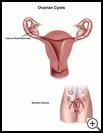
Ovarian Cyst
________________________________________________________________________
KEY POINTS
- An ovarian cyst is a fluid-filled sac in or on an ovary that may cause pain or changes in your menstrual cycle.
- You may not need treatment for an ovarian cyst, or you may be treated with drainage, medicine, or surgery.
- If you tend to have ovarian cysts often, your healthcare provider may recommend that you take birth control pills to help keep the cysts from coming back.
________________________________________________________________________
What is an ovarian cyst?
An ovarian cyst is a fluid-filled sac in or on an ovary. The 2 ovaries are part of the female reproductive system. They produce eggs and the female hormones estrogen and progesterone.
What is the cause?
Every month, during a normal menstrual cycle, an egg in one of the ovaries grows in a tiny sac. When the egg is mature, the sac breaks open to release the egg. The egg travels through the fallopian tube to the uterus, where it may get fertilized during sex and develop into a baby. After release of the egg from the ovary, the sac dissolves.
A cyst may form if a sac doesn’t break open to release an egg. It may keep growing for a while. Or, after release of the egg, the sac may not dissolve and fluid may build up in the sac, causing it to get bigger. These 2 types of cysts are the most common and often go away in 1 to 3 months without treatment. They don’t usually happen after menopause.
You have a higher risk for an ovarian cyst if:
- You have pelvic inflammatory disease, which is an infection of the female reproductive organs
- You have endometriosis, which is abnormal growth of uterine tissue outside the uterus
- You have bulimia, which is an eating problem
- You are taking fertility drugs to get pregnant
What are the symptoms?
Ovarian cysts often do not cause any symptoms. When they do cause symptoms, they may include:
- Pelvic pain that may go into your back or thighs
- Pain during sex
- Changes in menstrual periods such as heavy periods, painful periods, or no periods
- A feeling of fullness in the belly or pelvis
- Pain during bowel movements
- Frequent need to urinate or feeling like you cannot fully empty your bladder
It’s important for cysts to be found early and treated if necessary. If a cyst does not go away, sometimes it may burst (rupture). This can be very painful and could lead to bleeding inside the belly and the need for emergency surgery. If a cyst twists the ovary, it can cause severe belly pain, nausea, and vomiting. Sometimes, emergency surgery may be needed to untwist the ovary and try to keep the ovary from dying.
How is it diagnosed?
Your healthcare provider will ask about your symptoms and medical history and examine you. Tests may include:
- Ultrasound, which uses sound waves to look at the ovaries (the most common test)
- CT, which uses X-rays and a computer to show detailed pictures of the ovaries
- MRI, which uses a strong magnetic field and radio waves to show detailed pictures of the ovaries
- Laparoscopy, which uses a small lighted tube put into the belly through a small cut to look at the ovaries. A biopsy may be taken to help make a diagnosis. A biopsy is the removal of a small sample of tissue for testing.
- Blood tests
Your healthcare provider may find a cyst during a routine pelvic exam.
How are they treated?
Ovarian cysts often go away on their own within 2 or 3 menstrual cycles. Cysts that don't go away can sometimes be drained with a needle through the belly or vagina, using ultrasound to guide the needle into the cyst.
Very large cysts that don't go away after 3 menstrual cycles may be treated with hormone medicine or they may be removed with surgery. Cysts that are twisting the ovary usually need to be removed with surgery right away so that they don't damage the ovary.
How can I take care of myself?
You should have regular pelvic exams as often as your healthcare provider recommends. Routine exams will help ensure that changes in your ovaries are diagnosed as early as possible.
Follow your healthcare provider's instructions. Ask your provider:
- How and when you will get your test results
- How long it will take to recover
- If there are activities you should avoid and when you can return to your normal activities
- How to take care of yourself at home
- What symptoms or problems you should watch for and what to do if you have them
Make sure you know when you should come back for a checkup. Keep all appointments for provider visits or tests.
How can I help prevent ovarian cysts?
If you tend to have ovarian cysts often, your healthcare provider may recommend that you take birth control pills to help keep the cysts from coming back.

